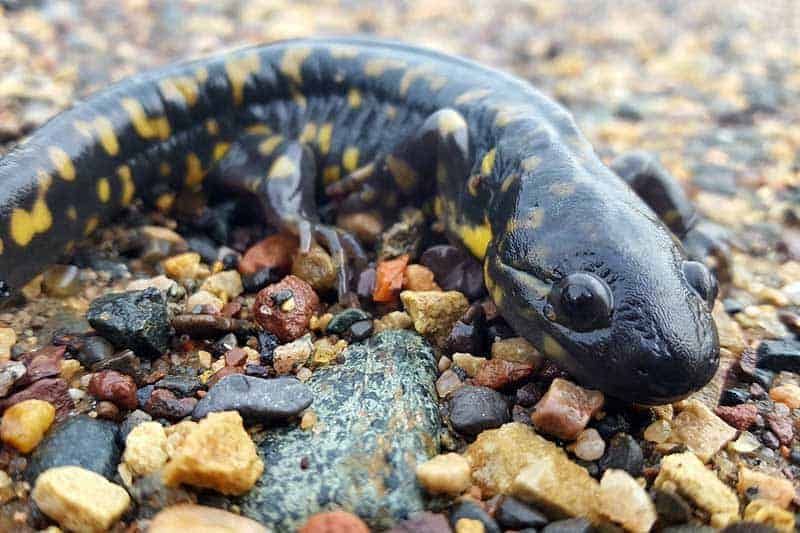The state of Wisconsin is home to 19 different species of amphibians. This includes frogs like toads and tree frogs, but also salamanders and newts. Salamanders are a unique group of sometimes vibrantly colored amphibians recognized by their resemblance to a lizard. They are however much more closely related to a frog.
Salamanders can either be semi-aquatic, fully-aquatic, or terrestrial. They range in size from very tiny, to gigantic. Because they can vary in size, so will their diets. Depending on their size and habitat, salamanders will eat small insects worms, slugs, snails, or anything else they can catch.
Let’s learn more about Wisconsin’s salamanders and look at some pictures.
7 Salamanders in Wisconsin
The 7 species of salamanders in Wisconsin are the blue-spotted salamander, four-toed salamander, eastern tiger salamander, eastern newt, mudpuppy, spotted salamander, and the red-back salamander.
1. Blue-spotted salamander
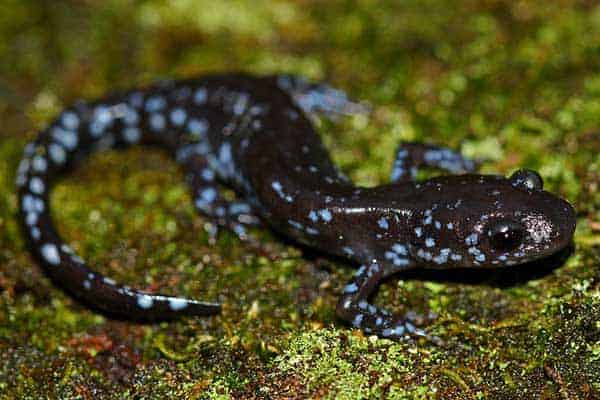
Scientific name: Ambystoma laterale
The blue-spotted salamander has a dark bluish-black body covered in lighter bluish-white speckles and spots. This species is considered a mole salamander and is endemic to the great lakes region of the country. In Wisconsin you’ll find blue-spotted salamanders throughout most of the state in deciduous and coniferous forests.
While not deadly to humans, blue-spotted salamanders are poisonous just like other salamanders. They are able to secrete poisonous through their skin as a defense against predators. Their bright colors are also a warning sign that they are poisonous.
The blue-spotted salamander has a long tail and can reach 3-5 inches in length as an adult, they are considered somewhat slender for a salamander.
2. Four-toed salamander
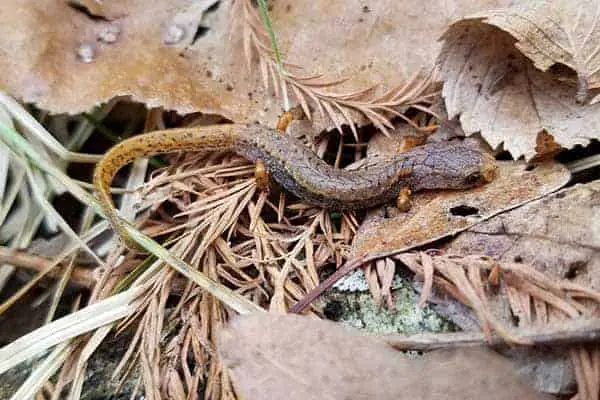
Scientific name: Hemidactylium scutatum
The four-toed salamander is often mistaken for the redback salamander, but the four-toed salamander has a white underbelly sprinkled with black dots. On top they are orange-brown or red-brown in color.
As a self defense against predators they are able to drop their tails as a distraction or even play dead. They’re found throughout most of the state of Wisconsin, as well as much of the eastern half of the country.
3. Eastern tiger salamander

Scientific name: Ambystoma tigrinum tigrinum
Tiger salamanders are one of the larger species of salamanders in Wisconsin, growing to an average of 6-8 inches in length. However some specimens have grow to over a foot long, one was recorded at 13 inches. They’re found throughout much of the United States, including the lower half of Wisconsin.
They spend much of their lives burrowed underground making them difficult to spot, but they live in a variety of habitats including forests and even grassy open fields. Like most other salamanders, tiger salamanders prefer a moist habitat. Also like other salamanders, the tiger salamander eats small insects and invertebrates. Because of their slightly larger size they are even able to take down small frogs and smaller salamanders.
4. Eastern newt

Scientific name: Notophthalmus viridescens
The eastern newt is a very common salamander in the eastern half of the United States. The subspecies of the eastern newt found in Wisconsin is the central newt, they are found in patchy areas all over the state.
Eastern newts live in deciduous and coniferous forests as well as bodies of water with muddy bottoms. They are between 2.5 and 5 inches in length as adults and feed on insects, fish, eggs and larvae, snails, slugs, and worms.
5. Mudpuppy
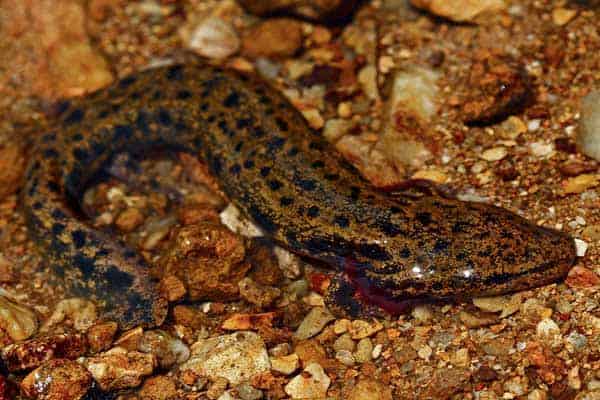
Scientific name: Necturus maculosus
The mudpuppy is common throughout most areas of central-east and northeast united States. In Wisconsin you’ll find mudpuppies at the bottoms of ponds, streams, lakes, and other bodies of water throughout the entire state.
Mudpuppies are totally aquatic salamanders but are equipped with both lungs and feathery red aquatic gills, though the lungs are mainly used to help with buoyancy as they never leave the water. They are one of Wisconsin’s largest species of salamanders and can reach up to 16 inches in length as adults, though most are closer to 11-12 inches.
6. Spotted salamander

Scientific name: Ambystoma maculatum
The spotted salamander is a medium to large salamander that grows to between 6 and 9 inches in length as an adult. The females do grow larger than the males however. They have thick, heavy bodies with a rounded snout. Spotted salamanders are dark brown or black in color with yellow or orange spots all over their bodies.
Spotted salamanders around only found in the eastern half of the United States, though they do not occur in Florida or Southern Georgia. In Wisconsin they are found mainly in the northern half of the state, but also to the east in proximity to Lake Michigan. They live hardwood or mixed forests and prefer sticking close to stagnant water sources and swamps.
7. Red-backed salamander
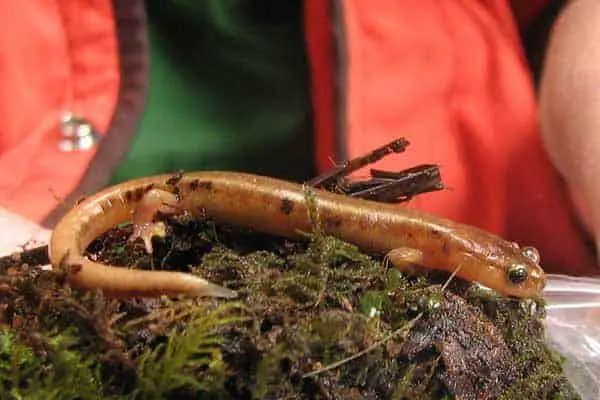
Scientific name: Plethodon cinereus
The red-backed salamander is commonly found throughout the Great Lakes region, New England, and Northeast United States. This includes the northern half of Wisconsin. They are very common within their range and are completely terrestrial salamanders.
Red-backed salamanders are on the small side and only reach 2-4 inches as adults. They stay hidden in forests and wooded areas underneath rocks, logs, and anything else they can find.
This species feeds mainly on insects but is opportunistic and will eat other types of invertebrates. There are different color morphs of the red-backed salamander, so they may also be yellow-backed, orange-backed, or even white-backed.
